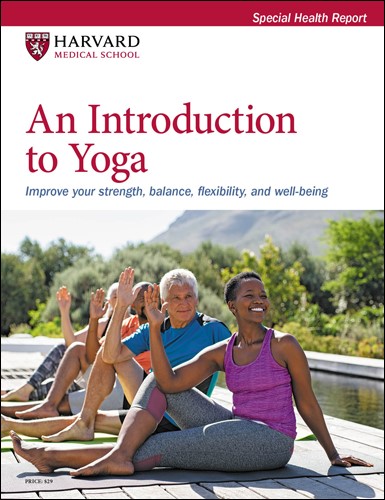Harvard Health Blog
Yoga could slow the harmful effects of stress and inflammation
- Reviewed by Howard E. LeWine, MD, Chief Medical Editor, Harvard Health Publishing; Editorial Advisory Board Member, Harvard Health Publishing

Stress accounts for between 60% and 80% of visits to primary care doctors. Chronic stress has been linked to accelerated biological aging, and increased chronic inflammation and oxidative stress, two processes that cause cellular and genetic damage. Scientists refer to chronic, low-grade inflammation in the body as "inflammaging." Inflammaging has been associated with conditions like diabetes, heart disease, stress, depression, and a weakened immune system.
Several recent studies suggest that yoga could slow the harmful physical effects of stress and inflammaging. There are many different types of biomarkers in the blood that can be used to measure the level of chronic inflammation and stress in the body. Cortisol varies throughout the day based on the circadian rhythm, and a higher baseline level of cortisol is one indicator of high chronic stress. Cortisol becomes less variable throughout the day in people who are chronically stressed, signaling an overactive fight-or-flight or sympathetic nervous system. Another biomarker is brain derived neurotrophic factor (BDNF), a naturally occurring protein in the body that regulates neuroplasticity and promotes brain development. People who have depression, anxiety, or Alzheimer's disease have been found to have lower levels of BDNF.
Studying yoga's effects on stress
In an exploratory study published in Oxidative Medicine and Cellular Longevity, researchers found that 12 weeks of yoga slowed cellular aging. The program consisted of 90 minutes of yoga that included physical postures, breathing, and meditation five days a week over 12 weeks. Researchers found indications of lower levels of inflammation and significantly decreased levels of cortisol. The study also found higher levels of BDNF after the yoga program, suggesting that yoga could have potential protective effects for the brain as well.
In another recent study published in Frontiers in Human Neuroscience, researchers found that a three-month yoga retreat reduced inflammation and stress in the body. The yoga retreat incorporated physical postures, controlled breathing practices, and seated meditations. Participants did two hours of sitting meditation, one to two hours of moving practice, and one hour of chanting daily. Levels of protective anti-inflammatory markers increased after the retreat, while harmful pro-inflammatory markers decreased. Researchers also found that BDNF levels tripled. Participants felt less depressed, less anxious, and had fewer physical symptoms.
These studies suggest that yoga could slow down the harmful effects of chronic stress at both the psychological and physical levels. It also indicates the benefits of a yoga practice that incorporates more than just poses by including yoga breathing and meditation or deep relaxation.
There are many simple yoga breathing (pranayama) techniques that can lower your stress levels that you can do at home for as little as a few minutes a day. Yoga breathing types can be calming or activating, depending on the type. One example of a calming yoga breath is alternate nostril breathing. You can practice it for as little as one to two minutes at home.
Alternate nostril breath (Nadi shodhana)
- Sit in a comfortable seated position, perhaps with your back supported by a wall.
- Close your eyes, reminding yourself not to judge anything you're doing.
- Take a few slow breaths in and out.
- Rest your left hand on your left knee.
- Fold your ring finger and little fingers toward the palm on your right hand.
- Place the index and middle fingers of your right hand in the middle of your forehead, between your eyebrows. You can also curl your index and middle finger toward your palm and rest them on your forehead if that feels more stable.
- Exhale slowly through your nose, allowing your lungs to empty completely.
- Close your right nostril with your thumb.
- Inhale gently and slowly through your left nostril for 5 counts.
- Press and close your left nostril with your ring and little fingers. Hold for 2 counts.
- Lift your thumb to release your right nostril, and exhale slowly through your right nostril for 5 counts. Stay empty for 2 counts.
- Inhale gently and slowly through your right nostril for 5 counts.
- Press and close your right nostril with your thumb. Hold for 2 counts.
- Release your left nostril, and exhale through your left nostril for 5 counts. Stay empty for 2 counts.
- Start another cycle by inhaling through your left nostril. Continue to this pattern for 10 cycles. After you exhale from one nostril, remember to breathe in from that same nostril before switching.
You can find additional breathing techniques, over a hundred yoga poses, and basic meditation techniques in The Harvard Medical School Guide to Yoga.
To learn how unhealthy levels of inflammation can affect the brain, see "Inflammation and Brain Health" in Harvard Medicine magazine.
About the Reviewer

Howard E. LeWine, MD, Chief Medical Editor, Harvard Health Publishing; Editorial Advisory Board Member, Harvard Health Publishing
Disclaimer:
As a service to our readers, Harvard Health Publishing provides access to our library of archived content. Please note the date of last review or update on all articles.
No content on this site, regardless of date, should ever be used as a substitute for direct medical advice from your doctor or other qualified clinician.
















